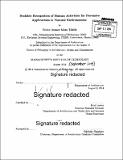Scalable recognition of human activities for pervasive applications in natural environments
Author(s)
Mota Toledo, Selene Atenea, 1976-
DownloadFull printable version (19.21Mb)
Other Contributors
Massachusetts Institute of Technology. Department of Architecture.
Advisor
Kent Larson.
Terms of use
Metadata
Show full item recordAbstract
Past approaches on the automatic recognition of human activities have achieved promising results by sensing patterns of physical motion via wireless accelerometers worn on the body and classifying them using supervised or semi-supervised machine learning algorithms. Despite their relative success, once moving beyond demonstrators, these approaches are limited by several problems. For instance, they dont adapt to changes caused by addition of new activities or variations in the environment; they dont accommodate the high variability produced by the disparity in how activities are performed across users; and they dont scale up to a large number of users or activities. The solution to these fundamental problems is critical for systems intended to be used in natural settings, particularly, for those that require long-term deployment at a large-scale. This thesis addresses these problems by proposing an activity recognition framework that uses an incremental learning paradigm. The proposed framework allows learning new activities - or more examples of existing activities - in an incremental manner without requiring the entire model to be retrained. It effectively handles within-user variations and is able to reuse knowledge among activities and users. Specifically, accelerometer signals -generated by 3-axis wireless accelerometers worn on the body- are recognized using a machine-learning algorithm based on Support Vector Machine classifiers coupled with a majority of voting algorithm. The algorithm was implemented and evaluated using datasets collected at experimental, semi-naturalistic, and naturalistic settings. Hence, compared to other state-of-the-art approaches, such as Hidden Markov Models or Decision Trees, the system significantly improves the between-class and between-subject recognition performance and requires significantly less data to achieve more than 90% within-class overall recognition rate. Based on this approach, a functional system was designed and implemented across a variety of application scenarios (from a social-exergame for children to a long-term data collection of physical activities in free-living settings). Lessons learned from these practical implementations are summarized and discussed.
Description
Thesis: Ph. D. in Architecture: Design and Computation, Massachusetts Institute of Technology, Department of Architecture, 2014. Cataloged from PDF version of thesis. Includes bibliographical references (pages 129-146).
Date issued
2014Department
Massachusetts Institute of Technology. Department of ArchitecturePublisher
Massachusetts Institute of Technology
Keywords
Architecture.